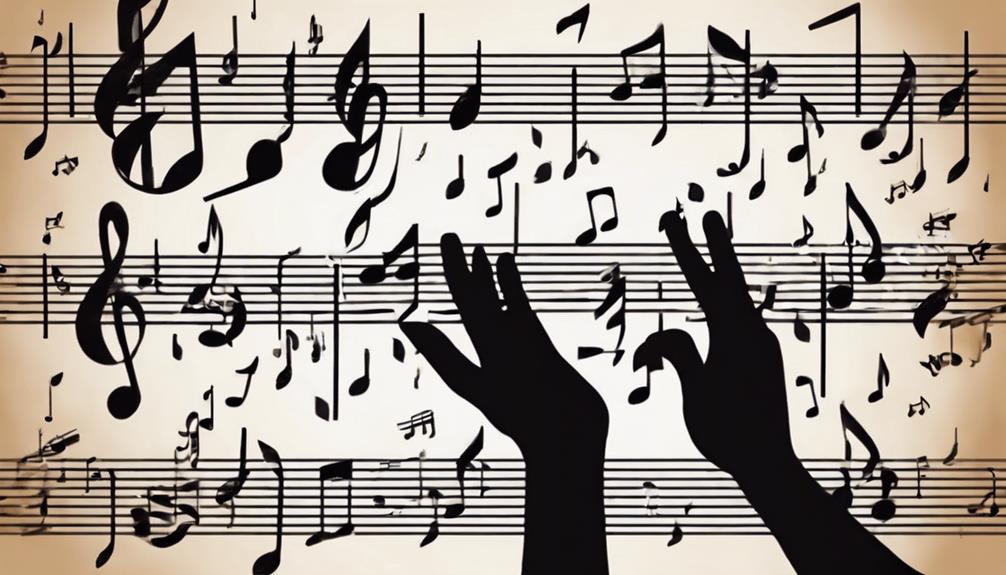No products in the cart.
Just as a painter must understand the nuances of color to create a masterpiece, you too must master the scales to sculpt soundscapes in music production.
It’s not merely about memorizing patterns; it’s about internalizing the language of music to communicate emotion and story through your creations.
You’ll start with the building blocks—the major and minor scales—which are the keystones of melody and harmony.
As you progress, you’ll explore the rich textures that pentatonic and blues scales can add to your work, and how modes can shift the mood and character of your pieces.
But remember, knowing the scales is one thing; using them effectively to breathe life into your compositions is another.
By the end of this discussion, you’ll not only be equipped with seven pivotal tips to elevate your scale game but also understand how to wield them to craft compelling music that resonates.
So, let’s begin your journey through the foundational elements of music production, where each scale you learn is a new color on your palette, waiting to be blended into your next sonic artwork.
Key Takeaways
- Internalize the sequence of whole and half steps in major and minor scales to understand their structure and patterns.
- Experiment with different starting notes to create fresh modes and explore the emotional landscapes of major and minor scales.
- Pay attention to the raised seventh degree in the harmonic minor scale and utilize the melodic minor scale’s dual approach for complex challenges.
- Use minor scales and their variations (natural, harmonic, and melodic) to add depth, drama, and contrast in music composition, harnessing their emotional impact across various genres.
Mastering Major Scales

To master major scales, you’ll need to internalize their sequence of whole and half steps, which forms the backbone of countless melodies and harmonies in music production. Grasping the W-W-H-W-W-W-H formula isn’t just about memorization; it’s about understanding the sonic architecture of Western music.
Here’s a blend of technical acumen and innovative thinking to transform your scale practice into a creative laboratory.
First, incorporate auditory, visual, and kinesthetic learning. Sing the scales as you play, visualize the notes on the staff, and feel the intervals under your fingers. This multi-sensory approach cements the patterns in your musical mind.
To innovate, manipulate scales by starting on different notes, creating fresh modes that inspire unique compositions.
When practicing major scales, avoid the common mistake of rote repetition without intention. Instead, use a metronome to challenge your tempo and rhythm, and record your sessions to critique and refine your technique.
Always strive to play with expression, even during scale practice, to keep the musicality at the forefront.
Exploring Minor Scales
You’ll find that grasping the basics of the natural minor scale, with its step pattern of whole and half steps, is essential for crafting the foundation of your music’s emotional landscape.
When you tackle the harmonic minor scale, pay attention to the raised seventh degree—it’s the twist that adds a touch of tension and exotic flair to your compositions.
Meanwhile, the melodic minor scale offers a dual approach, adapting its intervals as you ascend or descend, giving you creative leverage to navigate complex melodic and harmonic challenges.
Understanding Minor Scale Basics
Why does the natural minor scale evoke such a profound sense of melancholy in music? It’s in the way the intervals are structured—Whole-Half-Whole-Whole-Half-Whole-Whole—that carves out the somber soundscape. Understanding minor scale patterns is pivotal to harnessing their emotional impact.
The minor third interval, distinguishing minor from major keys, injects a dose of sorrow or enigma into melodies.
As you delve deeper, you’ll encounter three variants: natural, harmonic, and melodic minor scales, each with a distinct flair for innovative composition. They’re integral to infusing your music with a sense of depth, drama, and contrast, whether you’re crafting a classical masterpiece or a metal anthem.
Songs like ‘Stairway to Heaven’ and ‘Nothing Else Matters’ are testimonies to the powerful emotional impact of minor scales in music.
Minor Scales Variations
Diving into the world of minor scales reveals a trio of variations—natural, harmonic, and melodic—each with its own distinct impact on music’s emotional landscape.
The natural minor scale forms the foundation, its pattern mimicking the major scale’s sequence but starting on a different note, infusing your tracks with a somber touch.
Now, let’s analyze the harmonic minor vs melodic minor.
The harmonic minor scale sharpens the seventh degree, introducing a tension that’s ripe for dramatic resolutions—perfect for stirring emotional depths.
In contrast, the melodic minor scale’s dual nature—altering notes when ascending and reverting when descending—smooths out melodic lines and harmonic progressions, yielding a more nuanced emotional expression.
These variations offer you a versatile toolkit for crafting compositions that resonate deeply with your audience’s feelings.
Composing With Minor Scales
Having explored the variations of minor scales, let’s now focus on how to effectively compose with these tools to evoke the desired emotional responses in your listeners.
Minor scales aren’t just for crafting melancholy; they can add complexity and richness to your musical narrative. Here’s how you can innovate:
- Exploring Minor Scale Modes
- Natural: Use its somber tones for reflective passages.
- Harmonic: Introduce a sense of unease or tension, perfect for climactic moments.
- Melodic: Elegantly transition between emotions, adding a dynamic touch.
- Creating Tension with Minor Scales
- Leverage their versatility across genres, from haunting blues solos to ominous metal riffs.
- Manipulate intervals to build suspense before resolving to a major key for impact.
Harness these scales to captivate and convey a spectrum of sentiments through your music.
The Role of Pentatonic Scales
Exploring the pentatonic scales reveals their critical role in shaping the soundscapes of various musical genres, providing a foundation for melodies and solos that resonate with simplicity and emotional impact. The emotional impact of pentatonic scales on music can’t be overstated; these five-note sequences often drive the core of a song’s expressive power, delivering a raw and universal connection to listeners.
To innovate within your productions, you’ll want to exploit the versatility of pentatonic scales. Techniques for incorporating pentatonic scales into different musical genres involve not just playing the scales themselves but understanding how they fit within harmonic contexts. For instance, in rock, pentatonic riffs create that edgy, hook-laden sound. In blues, they’re the backbone of soul-stirring solos. In electronic music, pentatonics can provide an organic touch to synthetic textures.
Your creative process should include experimenting with modal interchange, using pentatonic scales to navigate between major and minor feels, or layering them to build complex chord progressions. This approach can yield innovative harmonic structures that retain listener-friendly tonality.
Delving Into Blues Scales


Unleash the raw emotion in your music by mastering the blues scale, a tool essential for infusing your melodies and solos with the distinctive bluesy feel that’s central to genres like blues, jazz, and rock. The blues scale isn’t just a sequence of notes; it’s a palette for expressing the very soul of your musical voice.
Here’s how you can delve into the heart of blues scales:
- Understand the blueprint:
- Root, flat third, fourth, flat fifth, fifth, flat seventh
- Recognize the ‘blue’ notes (flat third, flat fifth, and flat seventh) for their emotional weight
- Key techniques for improvising with blues scales:
- Bend or slide into the blue notes for added expression
- Use repetition and rhythmic variation to build tension
Employing blues scales in your compositions isn’t just about the notes themselves—it’s about how you articulate them. To innovatively integrate blues scales into different genres, consider the following:
- Experiment with context:
- Jazz: Introduce chromaticism alongside the blues scale for complexity
- Rock: Combine bluesy riffs with powerful chord progressions to fuel intensity
Utilizing Modes Effectively
As you venture into the realm of modes, consider how modal interchange can infuse your compositions with unexpected twists and a rich harmonic tapestry.
Crafting melodies within these modes demands an analytical ear and a creative spirit, recognizing the unique intervals that give each mode its emotional color.
Harness these tools to sculpt musical passages that resonate with your artistic vision and leave a lasting impact on your listeners.
Exploring Modal Interchange
Delve into the world of modal interchange to harness the expressive power of modes and transform your music production with unique tonal colors and harmonic variations. This technique is a game-changer for:
- Modal interchange in popular music:
- Shift between parallel modes for fresh sounds.
- Revitalize chord progressions with unexpected modal flavors.
- Modal interchange in jazz improvisation:
- Craft solos that weave through various modal landscapes.
- Infuse your improvisations with rich, complex modal substitutions.
Identify opportunities to implement modal interchange by analyzing chord relationships and potential substitutions. Experiment with mixing modes to create intriguing harmonic progressions and captivating melodies.
Your productions will gain depth as you move beyond traditional diatonic boundaries, inviting listeners into a world of innovative musical exploration.
Crafting Modal Melodies
Exploring the unique character of each mode, you’ll find that crafting modal melodies is a key technique for infusing your music with a distinct emotional quality and depth.
Dive into the essence of modes, from the bright optimism of Ionian to the somber nuances of Aeolian, leveraging these sonic palettes to shape your compositions.
Modal interchange techniques are pivotal; they allow you to borrow from the diverse emotional landscapes of modes to enrich your harmonic progressions.
Focus on the characteristic intervals within modes to create unique melodic phrases that resonate with your desired mood.
By practicing mode mixture, you juxtapose unexpected modal elements, weaving a tapestry of sound that captivates and intrigues.
Your innovative use of modes can become your signature in the art of music production.
Chromatic and Whole Tone Scales


Venturing beyond traditional diatonic frameworks, you’ll find that chromatic and whole tone scales offer a palette of tones unrestricted by the conventional major and minor scale steps. These scales are crucial for innovative music production, as they inject a fresh sonic character into your compositions.
- Chromatic Scale
- Scale Practice:
- Master each semitone movement.
- Develop keen interval recognition; identify the half-step relationships.
- Creative Application:
- Use for tension-building passages.
- Apply chromatic mediants for harmonic depth.
- Whole Tone Scale
- Scale Practice:
- Familiarize yourself with the uniform whole-step pattern.
- Explore the ambiguous tonal center for improvisation.
- Creative Application:
- Craft dreamy, ethereal soundscapes.
- Experiment with augmented chords for a surreal effect.
As you delve into these scales, your auditory palette expands, enabling you to craft soundscapes that defy traditional boundaries. The chromatic scale’s half-step intervals offer a linear progression, while whole tone scales provide a symmetrical, open-ended structure. Both scales challenge your ear, fostering an advanced understanding of pitch relationships—vital for any forward-thinking producer.
Embrace their unconventional nature to propel your music into uncharted auditory territories.
Applying Scales in Compositions
Selecting the right scale is pivotal when you aim to evoke specific emotions and atmospheres in your music compositions. In the realm of jazz, applying scales isn’t just a matter of technicality; it’s an art form. The harmonic framework of jazz often relies on the use of modes derived from scales like the Dorian, Mixolydian, or even the blues scale. Each offers a unique palette of sounds, enabling you to craft solos that speak with intricate phrasing and colorful tensions.
When you dive into electronic music, the sonic landscape broadens. Here, incorporating exotic scales can transport your listeners to distant lands. Imagine using the Hungarian Minor or the Phrygian Dominant to infuse a track with an enigmatic or edgy quality. These scales can be the secret sauce that sets your electronic compositions apart, fostering an innovative auditory experience.
As you build melodies, toy with scale degrees to introduce dynamic shifts within your pieces. Chord progressions and harmonies must resonate with the chosen scale, weaving a coherent musical tapestry. Embrace scale variations and modes to layer complexity, ensuring your work isn’t just heard but felt.
Through persistent practice and exploration, you’ll master the alchemy of scales, giving life to music that captivates and resonates.
Frequently Asked Questions
How Can I Memorize Music Scales Fast?
To memorize scales quickly, you’ll want to integrate scale flashcards into your routine, leveraging the Circle of Fifths to decode patterns and craft innovative exercises that challenge your retention and recall efficiency.
How Do You Learn Scales Effectively?
You’ll learn scales effectively by integrating scale apps into your practice routine and embracing improvised playing, which fosters a deeper, innovative understanding and muscle memory of musical patterns. Experiment to find your unique sound.
How Do You Guess the Scale of a Song?
To guess a song’s scale, you’ll blend ear training exercises with scale detection software, sharpening your analytical skills to creatively deduce key signatures and innovate your approach to music production.
What Is the Best Order to Practice Scales?
You should practice scales in a sequence that builds complexity, starting with major and minor, then progressing to modal and chromatic, while focusing on precise fingering techniques for efficiency and dexterity.
Conclusion
You’ve ventured through the realms of major, minor, pentatonic, and blues scales, grasping their unique colors and textures.
By integrating modes, chromatic, and whole tone scales, you’ve expanded your sonic palette.
Now, apply these scales creatively in your compositions.
Remember, mastery is a journey. Keep experimenting, improvising, and refining.
Your dedication to practice will forge the path to your distinct musical voice.
Embrace the process, and watch your productions flourish with depth and originality.




